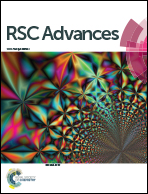Characterization of humic acids extracted from a lignite and interpretation for the mass spectra†
Abstract
Humic acids obtained from a Chinese lignite via alkali treatment were analyzed using Fourier transform infrared spectroscopy and Orbitrap mass spectrometry coupled with an electrospray ion source (ESI-Orbitrap-MS). Raw coal and the corresponding residue were characterized via scanning electron microscopy and energy dispersive spectrometry. Over 4700 heteroatom-containing compounds with wide distributions of molecular mass and unsaturation degree were detected via the ESI-Orbitrap-MS, and around 60 percent of the detected species were found to be oxygen-containing compounds. In addition, van Krevelen diagram and double-bond equivalent (DBE) plot were introduced to provide more structural details of the compounds. For the species only containing C, H, and O (HACHO), condensed aromatic compounds with a DBE value over 20 only contained 1 or 2 oxygen atoms. Carboxyl- and hydroxyl-containing aliphatic compounds (CHCACs) were predominant in HACHO with 5 or 6 oxygen atoms. Both the CHCACs and aromatic carboxylic acids or phenols were grouped into clusters in the van Krevelen diagram to be recognized. The introduction of a nitrogen atom to the HACHO species was based on the structures of the HACHO species, which is also indicated by the van Krevelen diagram.



 Please wait while we load your content...
Please wait while we load your content...